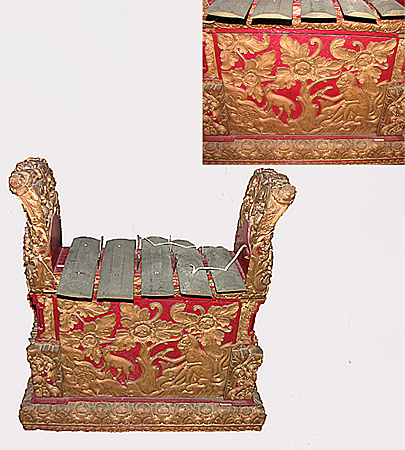
Owner: HWMC
Catalog#:2AS-IDST-72
Provenance: Al Thorp Collection
Metallophones/Xylophones
Bali ‘Gangsa’ (Jegogan)
Bali, Indonesia
Balinese
Wood, metal, leather, paint, bamboo
Mid 20th century
Height: 29.5 in, Width: 30 in
Idiophones – Struck Idiophones – Metallophones/Xylophones
The Gamelan is the traditional Indonesian tuned ensemble of the Balinese, Javanese, and Sundanese, made up of gongs, xylophones, and various stringed and wind instruments. In Bali, there are several types of gamelan orchestras, the largest (with some 25 players) being the Gong Kebyar and Semar Pegulingan. At the beginning of the 20th century, they were distinctively different, however since then they have become more alike both in form and function. These ensembles are predominately made of bronze metallophones, called gangsa.
This is a keyed metallophone (gangsa) called jegogan (jegog) with five bronze keys (1, 2, 3, 5, and 6), played in the Gamelan gong kebyar style/genre. Kebyar means “to flare up or burst open” and refers to the explosive changes in tempo and dynamics characteristic of the style. It is the most popular form of gamelan in Bali, and its best-known musical export.
This jegogan (Jegog) has a range of one octave and is one octave below the jublag. The five bronze keys on the jegogan are resting on suspended leather chords, over bamboo resonators with an ornately decorated caved wooden frame. The keys on the jegogan are considerably larger than those of other gangsa (metallophones) and are played with a large, cloth-coated, rubber-padded spherical mallet. The jegogan plays the key notes in the underlying melody, while sounding the deepest tuned notes in the ensemble. Usually there are two jegogan in kebyar, one male and one female.
Gamelan gong kebyar was first documented in North Bali in the early 1900s. Gong kebyar music is based on a five-tone scale called pelog selisir, and is characterized by brilliant sounds, syncopations, sudden and gradual changes in timbre (tone color), dynamics, tempo and articulation, and complex, complementary interlocking melodic and rhythmic patterns called kotekan.
Resource: Gamelan gong kebyar – Wikipedia; https://en.wikipedia.org/wiki/Gamelan_gong_kebyar; https://en.wikipedia.org/wiki/Gamelan_gong_kebyar#Gangsa_kantilan
